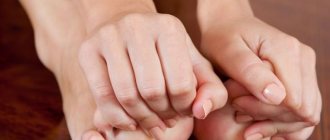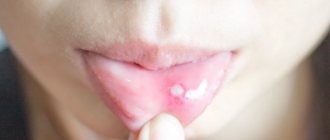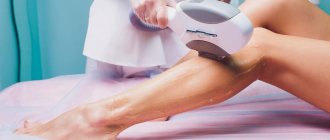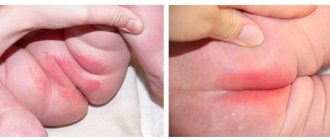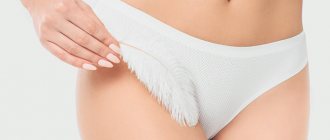No, these are two different procedures. During depilation, the visible part of the hair is removed, while the follicle remains unharmed, which allows the hair to grow back. The hair removal procedure, on the contrary, affects the entire hair and its bulb, allowing you to get rid of unwanted hair for a long time, and sometimes forever.
The most affordable and fastest way to remove hair is depilation. This method includes all popular cosmetic procedures, for example: waxing, sugaring, using depilatory creams or simply shaving hair.
However, each of these methods does not have the best effect on the skin, damaging it, causing inflammation, dryness, ingrown hairs and other troubles. This means that depilated areas need special care. This is the only way you can enjoy silky smooth skin.
Reasons for appearance
Why do acne appear after sugaring? This phenomenon indicates that complicated irritation has occurred on the skin. The reason for this may be:
- Very sensitive dermis. After hair removal, the skin becomes vulnerable, and pimples appear from the slightest contact with microorganisms or mechanical stress.
- Wrong work of a specialist. If the master does not know how clearly the procedure is performed, then complications are not far off.
- Uncleanliness. Do not epilate contaminated areas. The outcome of such manipulation is infection.
- Poor preparatory stage. Before sugaring, you need to do a scrub to remove dead cells and give good access to the follicles. It is important to do antiseptic treatment.
- Individual intolerance to components. If you are allergic to the composition of the paste or creams used, rashes may also appear.
- Lack of proper care. Afterwards you need antimicrobial treatment and moisturizing. It is advisable to do this in the following days. After three days you should scrub your skin.
- If there are toxins in the body or internal organs do not work properly, ulcers also occur. It is worth checking regularly and going to the hospital if you experience any discomfort.
- White pimples can occur in case of a sharp and systematic transition from sugaring to shaving.
White pimples appear most often in the bikini area after sugaring. This is due to the fact that the skin is most sensitive there.
Methods and means for treating acne
Once the problem is identified, you will need to fix it properly. Treatment of the consequences of sugaring depends on the area where the rash is located. Identifying the cause is usually not difficult. Then treatment begins. For this purpose, anti-inflammatory drugs are used, based on the scale and area of the lesion.
Medications
Microinflammations are treated based on the area of their formation.
The usual acne remedies - Metrogyl, Klenzit or treatment with tea tree oil - can deal with ulcers on the face.
Panthenol-based ointments and the use of salicylic acid can help with unsightly acne. Washing with mild cleansers and micellar water will only speed up healing. All these medications are used with the same success to treat pimples on the legs.
What to apply to pimples after sugaring bikini and armpits? These areas are considered sensitive. Drying aggressive compounds like salicylic acid are not suitable for them. It can cause irritation and worsen the condition. To relieve inflammation, use products containing panthenol, soothing herbal formulations, chlorhexidine and boroplus cream. You should not treat sensitive areas with ointment. The ointment forms a greasy film that will harm delicate areas with increased sweat and temperature.
Folk remedies for pimples after depilation
They can be used together with medications or separately - when there are contraindications or the skin is severely irritated. These methods include:
- Potato juice. Soothes and helps with regeneration. The potatoes are grated or chopped in a blender. The resulting paste is applied to the injured area several times a day.
- Solutions of iodine, alcohol. Such preparations are suitable for insensitive areas. It is not recommended to apply them in intimate areas.
- Chamomile tincture. Recommended for use to eliminate acne after bikini sugaring. Chamomile does not harm the delicate area, soothes and heals inflamed areas.
- Bee Honey. It is applied to inflamed skin while warm. The remaining honey is washed off.
If you are allergic to any folk remedy, you should not use it. It enters the body through the pores, and pustules after sugaring can develop into allergy ulcers.
How to prevent white pimples from appearing after the procedure?
To avoid white pimples on the skin, you need to be careful and prudent, namely:
- use an antiseptic solution before and after sugaring;
- Before sugar depilation, it is advisable to steam the skin;
- make a scrub a few days before the manipulation (2-3 days);
- do sugaring in sterile conditions and on clean skin;
- while working, wear gloves and make sure that the specialist is wearing them;
- When performing depilation yourself, follow the instructions strictly;
- choose an experienced master;
- do not visit ponds, baths and saunas three days before and after sugaring;
- do not rub the skin, do not wear tight or synthetic underwear for the first 3-4 days after depilation;
- Treat depilated areas daily with nourishing lotion;
- do not play sports;
- hold off on taking a hot bath;
- Do not smear your skin with deodorants for 1-2 days, do not apply decorative cosmetics, etc.
If you have dry epidermis, then in a couple of days you should soften it with nutrients.
With weak immune defense, cases of ulcers appearing are also common. To prevent this, take vitamin complexes and eat a healthy and balanced diet.
After the manipulation, you can treat the corresponding areas with a decoction of medicinal herbs (sage, chamomile, calendula, oak bark, string, etc.).
Folk remedies for purulent pimples after depilation
Consider a few healthy recipes:
- Chamomile lotion . Boil three large spoons of dry chamomile in two glasses of water. Strain the mixture and rinse the affected area with it.
- Aloe ointment. Make a paste from aloe pulp and apply it to pimples.
- Plantain compress . Wash the plantain leaves well and chop them into small pieces. Apply to the affected area and bandage for an hour.
Attention! Be careful, as components of folk remedies can cause allergies. If you have had an allergic reaction to any of the ingredients, do not use.
How to get rid of white pimples?
If pimples or blisters appear on the skin after sugaring, you should think about ways to eliminate them. This can be done using traditional methods and medications.
Drug treatment
Drugs such as:
- panthenol;
- bepanthena;
- rescuer;
- syntomycin;
- streptocid ointment;
- metronidazole;
- zenerite;
- levomekol;
- Vishnevsky ointment;
- ichthyol ointment;
- salicylic acid, etc.
Do not squeeze or pick out purulent formations. All this is fraught with infection.
Ointments are applied to the affected areas two to three times a day.
ethnoscience
If you don’t want to buy medications, try to do without them. Make a proven remedy yourself.
- Make rinses, baths or compresses based on medicinal herbs. Take raw materials of sage, chamomile, yarrow, string, etc., pour boiling water and leave for an hour. Then you can apply it.
- Take honey and add a few drops of rosemary, tea tree or lavender essential oil. Apply to pimples morning and evening. Tea tree can also be used as an independent remedy to burn single pimples.
- Use aloe. Place the porridge on the affected skin and walk like this for several hours.
- Calendula tincture can dry and disinfect. It’s easy to make it yourself from calendula and vodka. You will have to insist for at least a week. If you don’t have time, buy a ready-made tincture at the pharmacy. Take an ear stick, soak it in the mixture and cauterize the pimples.
Why do ingrown hairs appear after hair removal?
This side effect can easily occur if the procedure is carried out at home. However, unfortunately, some of our patients come to us with complaints about such a sad consequence after visiting a beauty salon. Let's try to find out what is causing this problem, let's look at what processes start in our body after hair removal and what they lead to.
Many doctors and cosmetologists unanimously assure that hair removal without ingrown hairs is an easily achievable procedure under certain circumstances. It all depends on the density of the dermis layer and the individual properties of the skin of an individual person. When the epidermis consists of a large number of keratinized cells and particles, it can be hard and thick. There is nothing bad or terrible about this. It is simply difficult for a cut hair to penetrate the protective layer of skin.
In the bottom picture you see that after the procedure, weakened hair cannot overcome the barrier on its own. It hits an obstacle and inflammation begins. The middle picture shows a different situation: the hair grows crookedly diagonally, since the root is injured, and as a result, it again rests against the skin barrier. And finally, the third example shows that even after breaking through the top layer of skin, the hair can bend slightly and begin to grow in another place.
Typically, people with darker, coarser hair are much more likely to experience ingrown hairs after hair removal. How to get rid of this without changing the structure of the hair, since this is simply impossible: you can influence the hair follicles using a laser beam. For this reason, the laser hair removal procedure in the clinic is considered the safest procedure in terms of the unpleasant consequences of ingrown hairs. By the way, dark hair grows faster than thin and light hair, this is directly related to hormones in our body.
Let's summarize the main reasons:
- too thick skin
- skin too thin
- several layers of the epidermis,
- hormonal characteristics,
- hair structure and color,
- improperly performed hair removal procedure (injury to the follicle).
There is another reason: genetic predisposition. Unfortunately, it cannot be prevented. If we are talking about hormonal levels, then it is the high level of estrogen that can affect the thickness and strength of the hair.
An exception is thin, colorless hair and fluff.
If you're used to shaving your hair in your own bathroom and don't trust qualified professionals, at least do it correctly. You cannot cut hair against its growth, use old blades, or manipulate without softening. To remove hardened cells, you can perform soft peelings, then the skin will be thinner and more tender. However, remember that frequent use of a scrub can lead to the opposite effect: the dermis will become so thin that any bent hair will inevitably grow nearby and become inflamed. By the way, the cause of ingrown hair in the intimate area can even be wearing tight, cut-in underwear and a love of synthetics (it interferes with air exchange and does not allow the skin to breathe).
Of course, you must understand that no one is safe from ingrown hairs, even if the session took place in a clinic or salon. Hair removal is not yet removal of the bulb; it continues to function, the hairs continue to grow, although weaker and thinner. After a few weeks they appear again and require repeat manipulation.
I would like to include in a separate group the impact of external factors, the appearance of which in our lives we ourselves regularly provoke. If you do not take care of your skin, it dries out and becomes rough, if you abuse the solarium and sunbathing without moisturizing the epidermis, if you do not even wash off the salt when leaving the sea (salt is very drying and tightens the skin), you can automatically fall into the risk group .
About the harm
Surely you are already wondering why ingrown hairs after hair removal are dangerous? Many girls who have encountered this problem post photos of the affected body parts on the Internet. Some come to solve it in a salon or clinic, which is the right decision.
So, if a few days after the session you notice burning and itching and see reddened spots in the treated area, take a closer look. Inflammation? Suppuration? A loop of hair under the skin? The place becomes denser, a tubercle appears. Since our body is geared towards certain processes, it perceives the appearance of such an “object” with alarm, considers it foreign and tries to push it out. Leukocytes take an active part in this mechanism; they are the ones who trigger inflammation. Some people do not notice this right away, mistaking the redness for a slight consequence after the procedure, which will disappear on its own in a couple of days, or even an allergic rash.
The danger of an ingrown hair lies precisely in the inflammatory process and suppuration. If dirt gets into an open wound, it can cause a serious infection. Any area on the body where hair removal has taken place is at risk. If there are lymph nodes nearby, bacteria that cause severe suppuration can spread throughout the body.
What serious consequences can there be:
- spread of infection
- hyperpigmentation (skin darkens in the area of inflammation),
- the appearance of scars and scars,
- inflammation of the hair follicle.
Any sane person understands that pus is not good. There are cases when the patient has a fever, this is how the body fights infection and inflammation. In severe cases, dermatologists are involved in treatment. Ideally, not only to recover, but also to avoid recurrence in the future.
When should you see a doctor?
If, after sugaring, pustules appear in the bikini area, which increase every day, and nothing helps, you should go to the hospital. You should not wait for the temperature to rise and the infection to spread to nearby tissues.
In case of delay and the abscess increases many times, the doctor may send you to a surgeon to open and pump out the purulent exudate. This occurs when contacting medical professionals is late.
What to do and how to treat?
There is no need to panic after discovering the disease.
In most cases, the problem is solved easily and quickly. The main thing is to find out the cause and start treatment. Here is a suitable algorithm of actions:
- Find out the reason. This is especially easy to do if the sugaring procedure was already carried out before the incident, but there were no such troubles.
- Take initial measures . You can read about them below.
- Start treatment . Choose the appropriate method and start eliminating acne.
Irritation after sugaring in the bikini area - what to do
The skin in the intimate area is very delicate and thin, and the hair has a rather large bulb. After sugaring, irritation almost always appears. Associated with mechanical impact when removing the strip, increased temperature of the caramel paste. This problem can be easily dealt with at home, which helps prevent dangerous consequences (dermatitis, inflammation and acne). You can find out how a photoepilator works in this article.
Causes of skin irritation
Skin irritation is a mild mechanical damage to the upper layer of the epidermis with a low level of inflammation (appears due to disruption of the blood vessels). Reasons for appearance:
- violation of technology;
- use of low-quality materials, paste;
- lack of personal hygiene;
- reduced immunity, skin sensitivity.
Especially often, irritation after hair removal occurs in women with very fair skin, as well as in the presence of thick hairs in the intimate area. Normally, symptoms go away on their own within 2-8 hours.
Sugaring is contraindicated during colds, pregnancy and chronic dermatological problems. The risk of complications after the procedure increases if the requirements for hair removal with sugar paste are not followed.
How to avoid these unpleasant consequences - prevention
To avoid adverse reactions afterwards, the following recommendations should be followed:
- prepare for the procedure, use an antiseptic and soothing ointment after the session;
- Before starting work, wash your hands with soap and sterilize your instruments;
- follow the hair removal technique;
- After removal, avoid visiting a solarium, sauna or steam bath for 3 days.
For a few days and for a week after, it is recommended to abandon synthetic underwear. After the procedure, it is important to monitor your health and regularly check the treated area.
How and with what to remove irritation and redness
There are several effective methods to relieve irritation and redness of the skin after sugar hair removal. The most effective ways to fight and remove irritation:
- immediately after removal, apply ice or another cooling element to the skin for 10 minutes;
- treat the skin with an antiseptic in the form of a solution or lotion;
- apply a soothing cream or compress from infusion of chamomile, calendula or celandine;
- in case of active redness or itching, use pharmaceutical ointment (Solcoseryl, Malavit or Boro Plus).
For those with oily skin, it is useful to use drying compounds, for example, salicylic, ichthyol or zinc ointment. They help regulate the functioning of the sebaceous glands and help avoid the appearance of pustules even in the deep bikini area.
conclusions
- Sugaring the bikini area is a relatively safe way to remove unwanted hair. May lead to irritation, inflammation, ingrown hairs and redness.
- If pustules appear, you should consult a doctor. Use antiseptics, wound healing ointments and anti-acne medications.
- Ingrown ones should be removed mechanically (tweezers, scrub). First you need to relieve skin inflammation and steam out the pores. In advanced cases, consult a doctor.
- Irritation is the most common complication after the procedure. Appears due to non-compliance with hair removal technology, the presence of health problems and increased sensitivity.
- After sugaring the intimate area, you need to apply ice, then use a disinfectant solution and a soothing cream. Avoid wearing thick synthetic underwear. We also recommend that you familiarize yourself with the contraindications and consequences of electrolysis in this material.
Folk methods of struggle
In addition to pharmaceutical cosmetics, homemade recipes are widely used to relieve irritation and reduce visible suppuration after hair removal with sugar paste. Simple and affordable ingredients of homemade masks and ointments make such procedures very common among women:
- Honey masks and applications. Honey is a natural remedy, rich in all the microelements and substances necessary for the body. Thick honey helps soothe injured skin, saturates it with vitamins and fights inflammatory processes developing in the sebaceous glands. To quickly get rid of pimples, itching and dryness, you can apply a small amount of honey melted in a steam bath to the skin, rub it with gentle massage movements and leave for several hours. After 3-4 hours, irritation should decrease or disappear completely.
- Potato juice. This simple remedy helps to quickly get rid of irritation and heal injured skin. Applying finely grated potatoes helps relieve redness and dryness throughout the day. In addition, this method of treating irritation prevents the development of pathogenic microflora in the deep layers of the skin and does not allow the development of complex forms of dermatitis.
It is important to understand that a remedy that works for one person may not help another at all, and in some cases even harm. Before using any product, it is necessary to conduct an allergy test. To do this, apply a small amount of the selected product to the inner surface of the forearm (this is where the most sensitive skin is located). If within 2-4 hours no red spots or peeling have appeared in the area where the product was applied, then you can safely apply the treatment to large areas of your body.
Sugaring is a new and fashionable procedure for removing unwanted hair. However, not every girl is suitable for depilation with sugar paste. It is important to take into account all the features of your own body and body, check for allergies to such sugar mixtures and choose a competent cosmetologist who is well acquainted with all the intricacies of the procedure and subsequent care.
How to avoid irritation in women?
It is unlikely that it will be possible to completely avoid irritation during sugaring and waxing. However, some tips will help you keep it minimal and get rid of red dots within a few days. In particular, it is important:
- Properly prepare the skin for the upcoming execution. In particular, it is very important to pre-treat the body with a scrub to remove dead particles of the epidermis. It is also necessary to use powder immediately before the procedure.
- Entrust the procedure to a professional or scrupulously follow the instructions.
- Properly treat the skin after the procedure, in particular, use chlorhexidine solution and Bepanten cream. Alcohol-containing products should be avoided.
- Do not wash for at least 6 hours after the procedure.
- Avoid physical activity for 12 hours and sunbathing for 48 hours.
- Avoid spa treatments.
- Wear clean and loose clothing and underwear.
In the future, just a few days after hair removal, it is important to follow the skin care specialist’s recommendations. This will help avoid complications in the future.
Prevention of purulent blisters
To avoid acne in the bikini area, on the face and other parts of the body, it is important to follow the same recommendations as described above. The main measure to prevent rashes is to follow the rules of basic hygiene:
- Epilation should be carried out on clean skin.
- It is best for the technician to wear gloves.
- The skin must be regularly treated with antiseptics.
- The epilated areas should not be touched again.
- Avoid visiting public places (swimming pool, sauna, etc.) until the skin is completely healed.
READ ALSO: Biorevitalization: what kind of procedure is it - what does the facial biorevitalization procedure give and do?
It is important for owners of highly sensitive skin prone to irritation and inflammation to inform the specialist about their characteristics in advance.
News MirTesen
